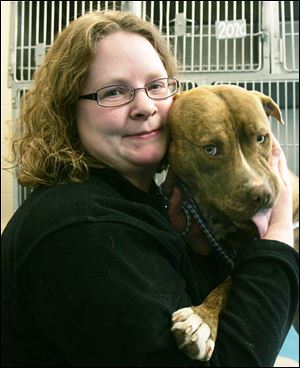
Warden's staff to use SAFER test to evaluate dogs for adoptability
5/17/2010
Dog Warden Julie Lyle, with 'pit bull' Amos, says the staff now uses a modified form of the test.
A standard exam of aggressive behavior that is used widely by animal shelters is being adapted for full-fledged use by the Lucas County dog warden.
Dog Warden Julie Lyle said her agency uses a modified version of the "Safety Assessment for Evaluating Rehoming" - SAFER, for short - but is moving to have her staff fully trained in the program.
And now with "pit bulls" becoming available for transfer for adoption for the first time, they too will be subjected to the SAFER test, Ms. Lyle said.
Dog Warden Julie Lyle, with 'Bower'
The program is a series of steps involving interaction with a handler and an observer aimed at prodding a dog into revealing whether it is likely to become aggressive when it is being handled, stared at, played with, and when around other dogs, or if its food and toys are taken away.
The "Safety Assessment for Evaluating Rehoming" was developed by Emily Weiss, an applied animal behaviorist and senior director of shelter behavior programs for the American Society for the Prevention of Cruelty to Animals.
"SAFER is the gold standard and as far as I know the most effective test for evaluating dogs for safe rehoming," said John Dinon, executive director of the Toledo Area Humane Society.
Ms. Lyle, who took over the county's dog warden office April 12, said the county dog pound downtown uses a modified version of SAFER in evaluating whether a dog is a candidate for adoption.
"When I came on board I would definitely say we were doing a modified SAFER. We are moving closer to a precise following of the SAFER steps and recommendations," Ms. Lyle said. "We are not all the way there yet, but we are very close."
The pound, for example, has just acquired a fake hand to use in testing whether an animal will bite if a food bowl or toy is taken away.
Not all dogs will be taken all the way through the exam.
"Sometimes we can't even get them out of the cage, which is failure [of the SAFER]," said Ms. Lyle, formerly of Ishpeming, Mich.
She said she has taken the two-day training in the SAFER system in the past. She said a previous employee had the training and passed on the information to the staff, but to her knowledge, none of the existing dog warden staff has received the two-day certification training. Mr. Dinon said he is scheduled to train Ms. Lyle's staff in SAFER in July.
The Humane Society has recently changed its policies to allow adoption of "pit bulls" for the first time. The agency, which protects animals against abuse, requires a "pit bull" to pass the SAFER test with flying colors.
Mr. Dinon said SAFER does not attempt to categorize a dog's personality or temperament but rather to predict if it will be a safe addition to a new home. The test has seven components.
Each examination involves a handler and an observer. The handler will do such things as gently hold the dog's head in his or her hands and briefly look directly into its eyes, knead large handfuls of skin, and pinch the toes.
The squeezing of dog testicles as part of the temperament test, as was done under the former county dog warden, Tom Skeldon, is no longer practiced at the county dog pound.
In the instructions for the "food aggression test," the handler uses a fake hand to pull food away that the dog has begun eating, while saying, "Give me that."
"This is repeated with handler first touching the dog's head, pushing against the dog's face, then pulling the bowl away," the instruction says.
Another test gauges the dog's reaction to other dogs. The two dogs are brought to within two feet of each other. Whether the dog's response is friendly or submissive, fearful, confident, or threatening and aggressive will usually determine whether it will face euthanasia or a new home.
An online guide to SAFER by the Humane Society of Missouri says that dogs earning a grade of C or better can be adopted, but not dogs scoring a D or F. According to the Missouri Humane Society, the grade of A means "the dog responded with relaxed or submissive body postures."
A grade of B means the dog responded with "fear-related behaviors or high-energy arousal," but no threatening behavior.
C is the grade for a dog that responded with confident behavior or tension and was highly aroused and rude with other dogs. Such a dog would require "significant modification" of its behavior.
Dogs getting the D grade responded with "extreme fear or threatening behavior." F is for dogs that responded with aggressive and dangerous behavior.
The Humane Society has accepted three "pit bulls" for adoption from the dog warden. Mr. Dinon said all three have passed the SAFER test with an A or a B grade.
"The state of Ohio still considers them to be inherently vicious dogs, and because of some of the societal perceptions we want to make sure we're doing our due diligence and being as cautious and conservative as we can," Mr. Dinon said.
"We're very good at screening out dogs that have a propensity to bite. If we adopt out a 'pit bull' that bites someone it's going to be a lot worse than if we adopted out a Chihuahua that bites someone," Mr. Dinon said.
He said dogs other than "pit bulls" have to pass all tests but not necessarily on the first try. For example, many dogs fail the food aggression test and have to be taught that food, at least in their new surroundings, is not a scarce resource, Mr. Dinon said.
Contact Tom Troy at:
tomtroy@theblade.com
or 419-724-6058.